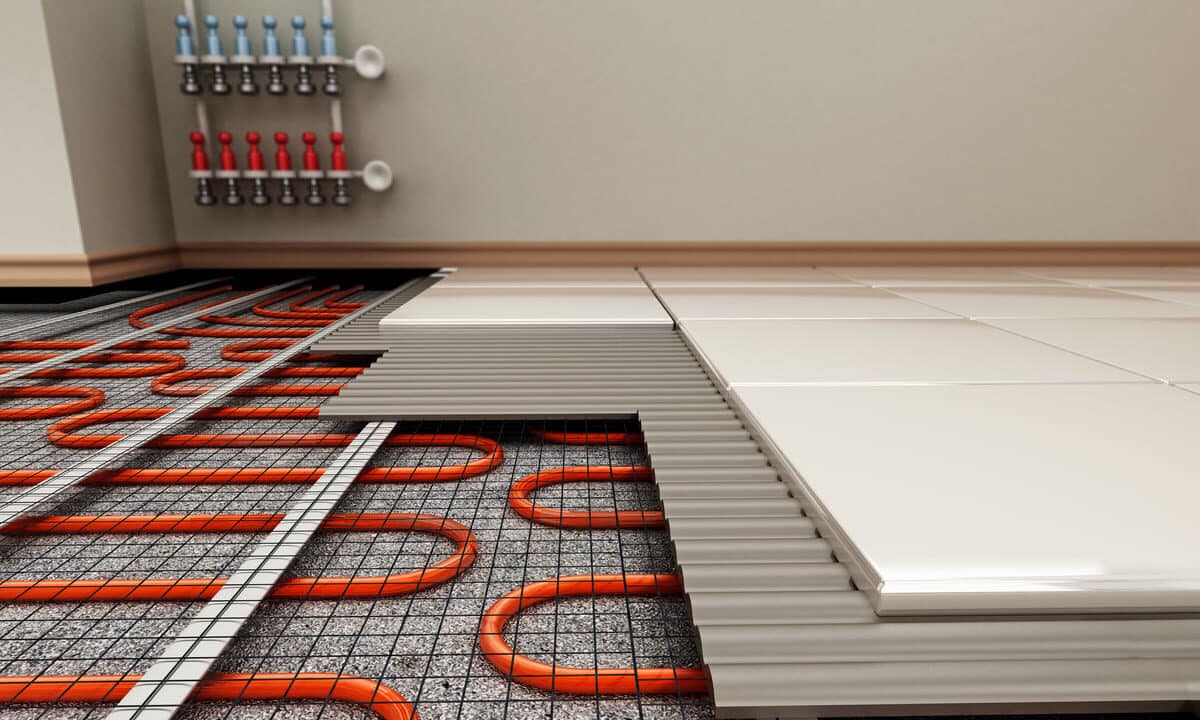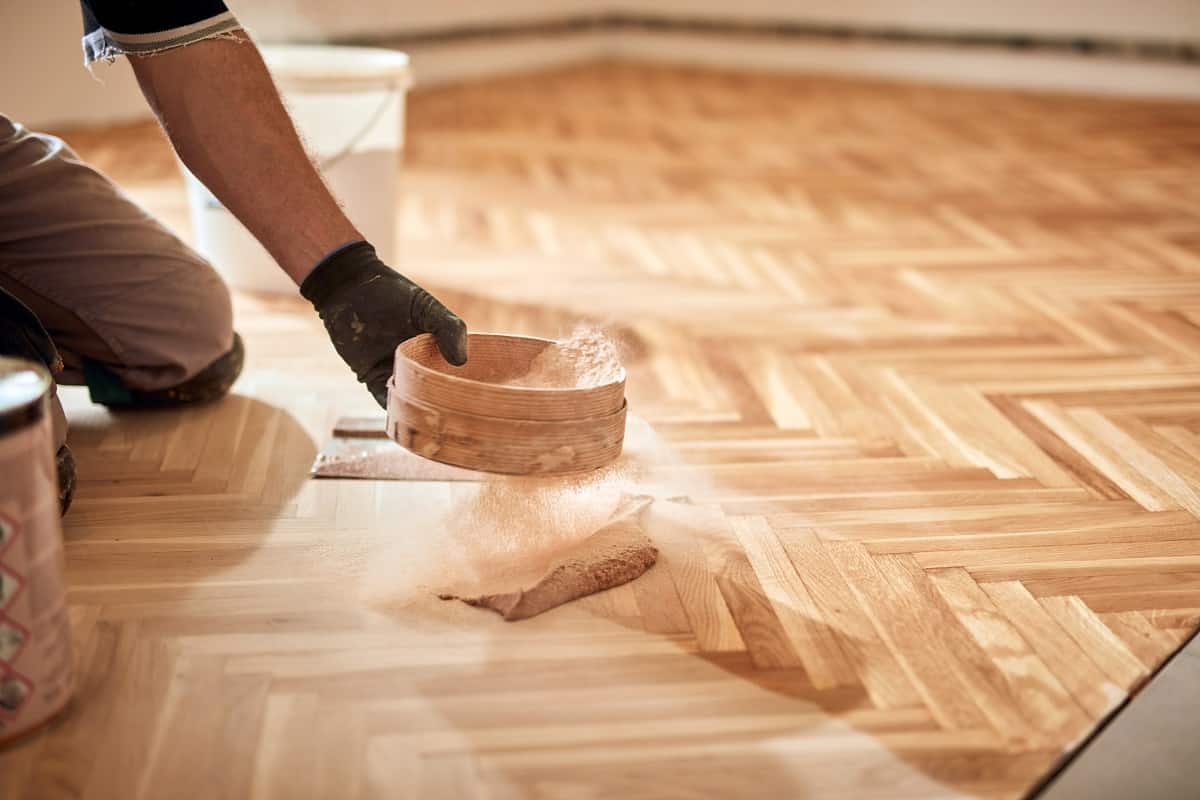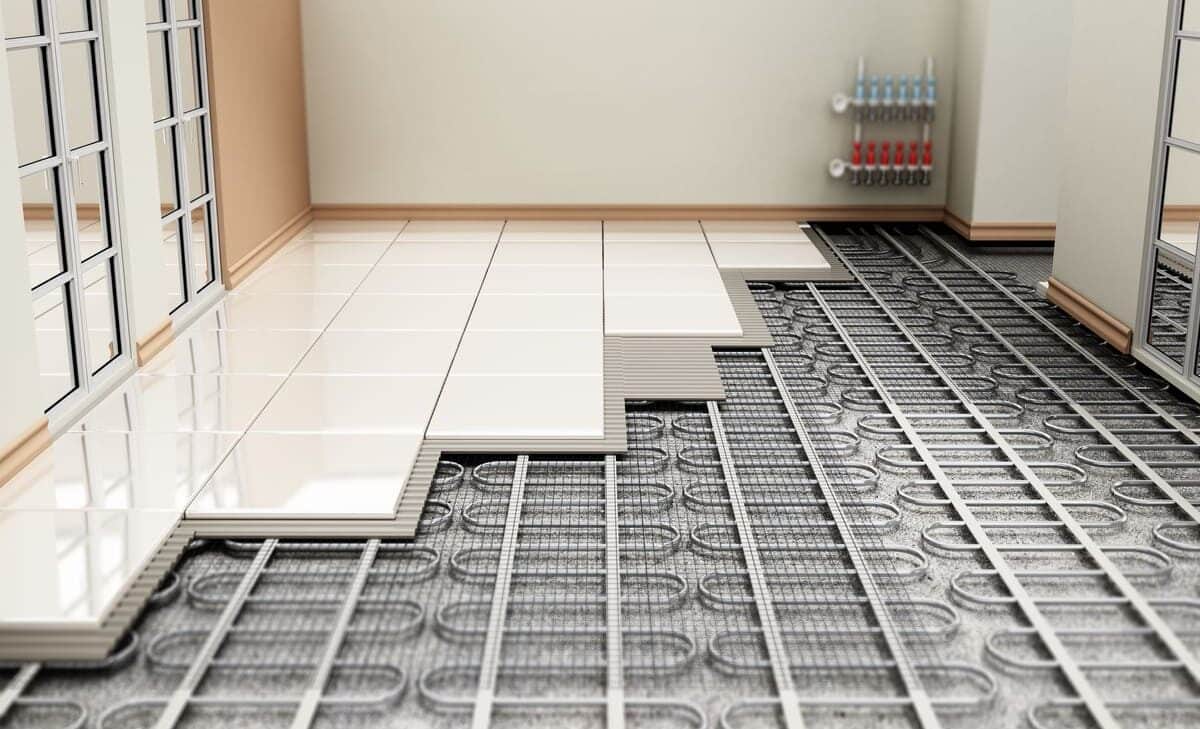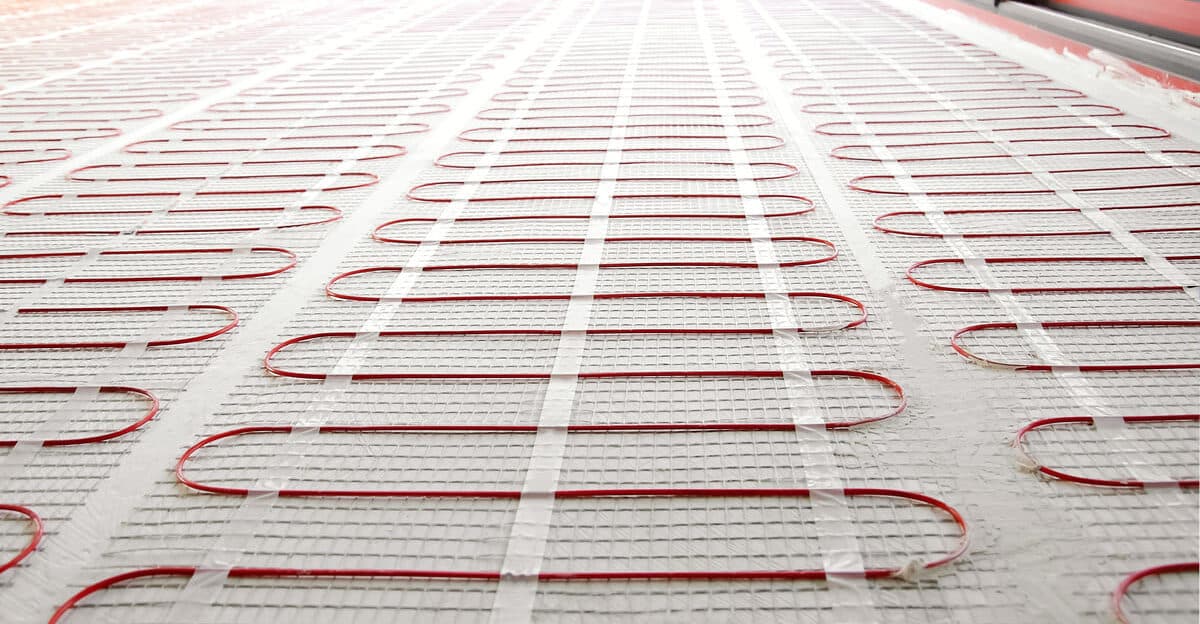When installing underfloor heating in a conservatory, it’s important to do your research first. Make sure you are aware of the different types of underfloor heating available and which type would be best for your particular situation. Additionally, consider any potential problems that could arise with installation – such as uneven floors or insufficient insulation. Researching these issues beforehand can help ensure that the installation process runs smoothly and without any unforeseen issues. Once you have all the necessary information on hand, you will be better equipped to make an informed decision about whether or not to proceed with installation.
Underfloor heating is a great option for conservatories, as it can provide efficient and reliable heat. The energy generated from the flooring warms up walls and roofs without having to use traditional radiators or air conditioning systems. This makes underfloor heating an ideal choice when it comes to conservatories as they are often exposed to cold temperatures during the winter months. Plus, with its low maintenance requirements, underfloor heating can be installed quickly and easily in most spaces. In this article we will look at what you need to consider before installing underfloor heating in your conservatory.
Types of Underfloor Heating Systems
Underfloor heating is an efficient and effective way to keep your conservatory warm. The two main types are wet and electric systems. Electric underfloor heating systems are a popular choice as they are easy to install, heat up quickly and cool down fast too. Water underfloor heating takes longer to heat up but it is also more energy efficient in the long run. Both options provide an excellent heating solution for your conservatory so it’s worth considering both before making a decision about which one would work best for you.
Choosing the Right Underfloor Heating System
When installing underfloor heating in a conservatory, it’s important to choose the right system for your needs. Cost, size and energy efficiency should all be taken into consideration when deciding which type of system is best for you. If you already have an existing central heating system in place, you may want to consider using a heating mat connected to this rather than investing in separate controls. Glass walls will lead to heat loss more quickly so take this into account when choosing your underfloor heating options too. Floor-heating mats are designed specifically for conservatories but these are usually pricier than traditional electric or water-based systems – make sure you factor this cost into your budget. Installing underfloor heating can be tricky so if necessary enlist professional help and advice before attempting to fit it yourself!

Installation Considerations
Underfloor heating is an ideal way to keep your conservatory warm and comfortable all year round, but it’s important that you get a professional installer to install the system. You need to ensure that the insulation in your conservatory is suitable for underfloor heating, and they will be able to calculate the best positioning of the system so you don’t lose any heat. For instance, if you have natural stone or tiled flooring in your conservatory, then these can act as good insulators against heat loss. An energy efficient heating solution such as underfloor heating in your conservatory also requires less maintenance than other types of heating systems, so it’s definitely worth considering when deciding how to heat your cold conservatory! A professional will also be able to do a full heat loss calculation before installing the system too.
Heat Output
It is important to select a system with the correct heat output for the size of the space. This will ensure that your conservatory can be heated efficiently and effectively all year round. The amount of heat needed depends on several factors such as wall space, type of flooring (ceramic tiling or solid walls), whether you have cold air coming through windows or doors and if you are using an electric system. It’s best to consult with a professional who can calculate how much heat is required based on these factors. Additionally, building regulations may stipulate certain requirements for ceramic tiles or stone floors in living spaces like conservatories so make sure you’re aware of this before installation begins.
Floor Thickness
When installing underfloor heating in a conservatory, it is important to consider the floor thickness. For optimal heat output and retention, the recommended floor thickness is between 60mm and 80mm. If your sub-floor has a finish of tiles or marble, you may need to increase this depth for better results. In terms of insulation materials, mineral wool should be used to ensure that the room evenly heats up when using electric UFH systems. It’s also worth noting that due to its complexity, installing underfloor heating in a conservatory can be a challenging DIY project for even experienced conservatory owners!
Floor Coverings
Floor coverings such as tiles, laminate and carpets are all suitable options for conservatories. By selecting an appropriate floor covering, you can get the most out of your system. The right choice will help lower temperatures in the room while using less energy than other types of heaters at floor level. Therefore, it is essential to choose wisely when considering what type of flooring to use in your conservatory.

Subfloor Preparation
Before installing an underfloor heating system in a conservatory, it is important to prepare the subfloor. This includes levelling the floor and checking for dampness. If any existing dampness is found, it must be treated before proceeding with installation of the system. Underfloor heating can provide one solution for keeping your conservatory warm during winter months, but it does require some preparation beforehand. Installing underfloor heating will also add extra cost to your project due to its complexity; however this could be offset by creating more space through not having radiators taking up wall space.
Heat Control
Consider the options available for controlling the temperature of the system. These include thermostats, timers and zone controls. This will help ensure that you get maximum efficiency from your installation, as well as preventing any build up of heat or cold spots due to insufficient insulation or flooring. It is also essential to take into account other factors such as window placement and energy usage when considering how best to control the temperature within your conservatory.
Timer Settings
When considering what to consider when installing underfloor heating in a conservatory, setting the timer correctly is essential. Not only will it help conserve energy, but it also offers a range of different settings that can be tailored to your specific needs. With options such as ‘always on’ and ‘night mode’, you can choose how warm you want your conservatory floor to be at any given time. Setting up a timer ensures that you are always getting the most out of your system while saving energy too!

Running Costs
Underfloor heating in a conservatory can be powered by electricity or water. Electric systems are more common and cost-effective, while water-based systems are better suited to larger spaces. To calculate the running costs of your system, you will need to know the wattage (for electric) or BTU rating (for water). The wattage and BTU ratings indicate how much energy is needed to run your system. Additionally, it’s important to consider insulation when installing underfloor heating as this can help reduce running costs significantly. Insulation helps keep heat in and cold out so that you don’t have to use as much energy for heating up your space. It also ensures that warm air doesn’t escape quickly after being heated up by the underfloor heater, allowing it to remain warmer for longer periods of time.
Maintenance
Underfloor heating systems in conservatories require regular maintenance to ensure they are working efficiently. This includes checking for leaks, flushing the system, and replacing filters. It is important to make sure these steps are done regularly so that the system continues to run smoothly and without interruption. Leaks can be detected with a pressure test or visual inspection of the pipes; this should be done at least once a year. Flushing involves running clean water through the system to remove any debris or sediment build-up which could lead to blockages; this should be done every two years as part of your routine maintenance plan. Replacing filters helps keep dust and other particles from entering into the system and should also be changed on an annual basis. By taking these steps you will help prolong the life of your underfloor heating system in your conservatory while ensuring it works as effectively as possible all year round.
Conclusion
Installing underfloor heating in a conservatory is an excellent way to make it more comfortable and usable all year round. However, there are some important factors to consider when making this decision. You must assess the insulation of your conservatory, take into account the amount of space you have available for installation, decide what type of flooring will work best with underfloor heating and consider whether or not it is worth investing in a thermostat. By taking all these aspects into consideration before purchasing your system, you can ensure that your underfloor heating is properly installed and provides maximum benefit.
Extra Questions You May Have
Is underfloor heating suitable for a conservatory?
Yes, electric underfloor heating systems are suitable for conservatories and can help to maintain a comfortable temperature naturally.
What type of flooring is best for use with underfloor heating in a conservatory?
Stone floors are a great option for use with underfloor heating in a conservatory, as they help to retain heat and provide energy efficiency. Stone floors also look great when paired with glass walls, creating a naturally beautiful aesthetic.
How much energy does underfloor heating use in a conservatory?
Underfloor heating is an efficient way to provide heat retention in a conservatory, as it can be installed naturally and does not require a lot of energy to run.
What temperature should i set my thermostat to when using underfloor heating in a conservatory?
The temperature you should set your thermostat to when using an electric underfloor heating system in a conservatory depends on how much natural heating the room receives. Generally, you should aim for a temperature of around 18-21°C, but this may vary depending on the size and orientation of the conservatory.
Are there any safety concerns associated with using underfloor heating in a conservatory?
Yes, there are safety concerns associated with using underfloor electric heating mats in a conservatory. It is important to ensure that the underfloor heating system is correctly fitted and that it meets the relevant safety standards. Radiators can also be used in a conservatory, but they may not be as efficient as an underfloor heating system.
How long will it take to install an underfloor heating system in a conservatory?
The installation of an underfloor heating system in a conservatory will depend on the size and complexity of the project. Generally, it can take anywhere from 1 to 4 days for a professional to install an underfloor heating system, including laying the floor finish naturally and ensuring that all separate heating controls meet building regulations.
Does the installation of an underfloor heating system require planning permission or building regulations approval? (wet systems may)
No, the installation of an underfloor heating system does not require planning permission or building regulations approval. However, wet systems may require such approval depending on the local regulations in your area. Underfloor heating is a great way to increase energy efficiency and create a comfortable atmosphere within your conservatory, especially when combined with stone floors which naturally retain heat.
What are the maintenance requirements for an underfloor heating system installed in a conservatory?
The maintenance requirements for an underfloor heating system installed in a conservatory depend on the type of natural stone used, as well as any building regulations that may apply to the windows. It is important to check with a qualified professional to ensure that all necessary safety and maintenance precautions are taken.
Are there any special considerations when installing an electric or water-based underfloor heating system into a conservatory?
Yes, when installing an electric or water-based underfloor heating system into a conservatory, there are several special considerations to keep in mind. Firstly, you must ensure that your heat loss calculation takes into account the fact that conservatories can be particularly prone to heat loss due to their glass roofs and walls. Additionally, it is important to check whether your local building regulations allow for the installation of underfloor heating systems in conservatories.
Is it possible to control the temperature of each individual room within the same conservatory if using an electric or water-based underfloor heating system?
Yes, it is possible to control the temperature of each individual room within the same conservatory if using an electric or water-based underfloor heating system. The ceramic tile helps retain warm air and reduce heat loss, allowing you to adjust the temperature in each room according to your needs.
Can i save money on my energy bills by using an electric or water-based underfloor heating system in my conservatory?
Yes, you can save money on your energy bills by using an electric or water-based underfloor heating system in your conservatory. Heat loss calculations should be taken into account when deciding which type of system to install, and building regulations should also be followed. Naturally, the more efficient the system is, the more you will save on energy costs.
Is it necessary to have insulation installed beneath the flooring when installing an electric or water-based underfloor heating system into my conservatory?
Yes, it is necessary to have insulation installed beneath the flooring when installing an electric or water-based underfloor heating system into your conservatory. This is because glass naturally has a higher heat loss calculation than other materials used in living spaces. Insulation will help to reduce the amount of heat lost through the floor and keep your conservatory warm.
Will my existing electrical wiring be able to support the installation of an electric or water-based under floor heating system into my conservatory ?
Yes, your existing electrical wiring should be able to support the installation of an electric or water-based under floor heating system into your conservatory. This type of energy efficient warm air flooring can provide a naturally comfortable atmosphere for you and your family to enjoy.
Can i control and monitor the temperature of my under floor heating from anywhere via wi-fi if i install it into my conservatory?
Yes, you can control and monitor the temperature of your under floor heating from anywhere via Wi-Fi if it is installed according to building regulations and the correct floor finish is used for the radiators.
Do you need a special boiler for conservatory underfloor heating?
No, you do not need a special boiler for conservatory underfloor heating. Mittens Underfloor Heating London provides an efficient and cost-effective solution for cold stone floors in conservatories, which can build up quickly in the winter months. Our underfloor heating systems are designed to be installed with any existing boiler, so you don't have to worry about purchasing a new one.

